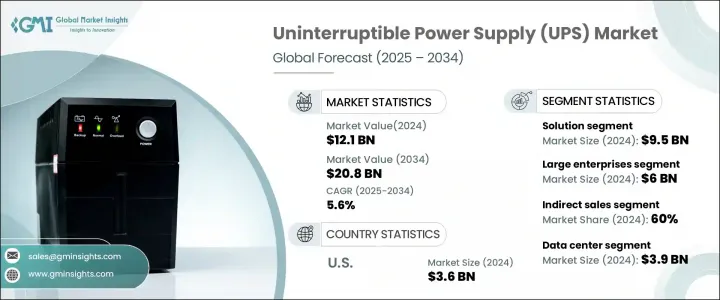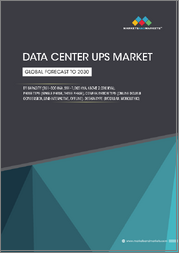
|
시장보고서
상품코드
1797861
무정전 전원 장치(UPS) 시장 기회, 성장 촉진요인, 산업 동향 분석 및 예측(2025-2034년)Uninterruptible Power Supply (UPS) Market Opportunity, Growth Drivers, Industry Trend Analysis, and Forecast 2025 - 2034 |
||||||
세계의 무정전 전원 장치(UPS) 시장은 2024년에는 121억 달러로 평가되었고, CAGR 5.6%를 나타내 2034년에는 208억 달러에 이를 것으로 추정됩니다.
성장의 원동력이 되고 있는 것은 세계의 디지털 인프라의 급속한 확대이며, 여기서는 전력의 안정적인 공급이 필수적입니다. 클라우드 컴퓨팅, 인공지능, 첨단 디지털 시스템의 채택이 증가하여 중요한 시설의 에너지 수요가 크게 증가하고 있습니다. 이러한 전력 소비의 급증은 중단 없는 작동을 보장할 수 있는 견고하고 고성능의 UPS 솔루션에 대한 직접적인 요구를 만들어 냈습니다.

산업계가 기술 중심의 운영으로 전환함에 따라 확장성이 높고 에너지 효율이 높고 지능형 UPS 시스템에 대한 수요가 급증할 것으로 예측됩니다. 제조업체는 진화하는 성능과 효율 요구 사항을 충족하기 위해 고급 모니터링 시스템, 향상된 배터리 기술 및 AI 주도 진단 통합에 주력하고 있습니다. 게다가, 부문에 관계없이 운영의 탄력성과 에너지 최적화가 강조되는 것은 시장의 꾸준한 상승 궤도에 영향을 미칩니다.
| 시장 범위 | |
|---|---|
| 시작 연도 | 2024년 |
| 예측 연도 | 2025-2034년 |
| 시작 금액 | 121억 달러 |
| 예측 금액 | 208억 달러 |
| CAGR | 5.6% |
구성 요소별로 시장은 솔루션과 서비스로 분류됩니다. 2024년에는 솔루션 부문이 시장을 선도해 총 매출의 80% 이상 약 95억 달러를 차지했습니다. 이 부문에는 대기(오프라인), 라인 인터랙티브, 온라인(이중 변환) UPS 시스템이 포함됩니다. UPS의 설치에는 자본 집약적인 성질이 있으며, 고급 전력 보호 시스템에 대한 수요가 높아지고 있는 것이 이 부문의 확고한 지위를 지원하고 있습니다. 기업이 기밀성이 높은 장비를 장애로부터 보호하려고 하는 동안 뛰어난 신뢰성과 효율성을 제공하는 솔루션이 큰 지지를 받고 있습니다.
조직 규모에서 대기업은 2024년 전체 시장 점유율의 54%를 차지하며 60억 달러에 가까운 수익을 올렸습니다. 이러한 기업은 일반적으로 복잡한 IT 인프라와 여러 데이터 시설을 운영하며, 고급 성능 기능을 갖춘 대용량 UPS 시스템의 필요성을 높입니다. 미션 크리티컬 시스템에 대한 의존은 무정전 전원 장치(UPS)를 우선 투자 분야로 삼고 있습니다.
판매 채널에 따라 시장은 직접 판매와 간접 판매로 구분됩니다. 간접 판매 채널은 2024년에 시장의 약 60%를 차지했고 2034년까지 약 5%의 연평균 복합 성장률(CAGR)을 나타낼 것으로 예측됩니다. 전체적으로는 간접 판매 채널의 점유율이 높지만, 대규모 설치와 고도로 맞춤화된 UPS 프로젝트에서는 직접 판매가 여전히 바람직한 옵션입니다. 직접 계약을 통해 공급자는 맞춤형 솔루션을 제공하고 고객과의 긴밀한 관계를 유지하며 특정 기술 요구 사항을 효율적으로 해결할 수 있습니다.
용도 관점에서 볼 때 시장은 BFSI, 데이터센터, 의료, 통신, 산업용도, 정부 및 방어 등을 포함한 섹터를 다룹니다. 데이터센터는 2024년 39억 달러를 차지했으며, 2034년까지 연평균 복합 성장률(CAGR)은 약 6.2%를 나타낼 것으로 예측됩니다. 이 부문은 디지털 작업 부하 증가와 운영 연속성을 보장하기 위해 신뢰할 수 있는 백업 전원 시스템의 필요성으로 빠르게 확대되고 있습니다.
지역별로 미국은 2024년 북미 시장의 75% 이상을 차지했으며 36억 달러의 매출을 기록했습니다. 그 강력한 존재는 첨단 기술 인프라와 대용량 UPS 도입에 대한 대규모 투자로 이어졌습니다. 디지털 오퍼레이션의 대규모화에 따라, 이 나라에서는 고효율로 AI 대응의 UPS 시스템에 대한 수요가 계속 증가하고 있습니다.
세계의 무정전 전원 장치(UPS) 업계에서 사업을 전개하는 주요 기업으로는 Vertiv, Schneider Electric, Legrand, Huawei, ABB, Socomec, Riello UPS, Eaton, Delta Electronics, Kstar 등이 있습니다. 경쟁은 여전히 치열하고 있으며, 제조업체들은 제품의 효율성, 모니터링 능력 및 통합 유연성을 높이기 위해 연구 개발에 많은 투자를 하고 있습니다. 시장은 리튬 이온 배터리, AI 기반 예측 진단, 클라우드 지원 모니터링을 포함하여 운영 성능을 향상시키는 솔루션으로의 전환을 볼 수 있습니다. 지능적이고 적응력이 뛰어나고 에너지 친화적인 UPS 시스템을 제공하는 데 주력하는 공급업체는 향후 몇 년 동안 시장에서의 입지를 강화할 것으로 예측됩니다.
목차
제1장 조사 방법
제2장 주요 요약
제3장 업계 인사이트
- 생태계 분석
- 공급자의 상황
- 이익률
- 비용 구조
- 각 단계에서의 부가가치
- 밸류체인에 영향을 주는 요인
- 파괴적 혁신
- 업계에 미치는 영향요인
- 성장 촉진요인
- 데이터센터의 폭발적인 성장과 디지털 변혁
- 전력 품질 문제와 정전에 의한 경제적 영향 확대
- 중요한 인프라 및 헬스케어 분야의 요건
- 5G 네트워크 인프라와 통신 확장
- 산업 자동화 및 제조업 성장
- 업계의 잠재적 위험 및 과제
- 총 소유 비용과 유지 보수 부담 증가
- 공급망의 취약성과 원재료 의존
- 시장 기회
- 에너지 통합 및 그리드 안정화 솔루션
- 하이퍼스케일 데이터센터와 클라우드 컴퓨팅 인프라의 폭발적인 증가
- 통신 및 5G 인프라 도입 가속
- 성장 촉진요인
- 성장 가능성 분석
- 규제 상황
- 북미
- 유럽
- 아시아태평양
- 라틴아메리카
- 중동 및 아프리카
- Porter's Five Forces 분석
- PESTEL 분석
- 기술과 혁신의 상황
- 현재의 기술 동향
- 신흥기술
- 가격 동향
- 지역별
- 제품별
- 생산 통계
- 생산 거점
- 소비 거점
- 수출과 수입
- 코스트 내역 분석
- 특허 분석
- 지속가능성과 환경 측면
- 지속가능한 관행
- 폐기물 감축 전략
- 생산에 있어서의 에너지 효율
- 환경 친화적인 노력
- 탄소발자국의 고려
- UPS 고장 분석 및 위험 평가
- 고장 모드 영향 해석(FMEA)
- 파워 일렉트로닉스 부품의 고장
- 소프트웨어 및 제어 시스템의 장애
- 통신 프로토콜의 장애
- 종합적인 사례 연구 분석
- 통계적 고장 분석
- UPS의 유형과 사이즈별 고장률 데이터
- 평균 고장 간격(MTBF) 분석
- 평균 복구 시간(MTTR) 통계
- 가용성과 신뢰성의 지표
- 비용 영향 분석
- 리스크 경감 전략과 대책
- 예방 유지보수 프로토콜
- 감시 및 진단 시스템
- 중복 설계의 원칙
- 스탭의 연수와 능력 개발
- 업계 모범 사례와 표준
- 온도 관리
- 배터리 관리 시스템
- 시스템 테스트 및 검증
- 긴급 대응과 복구
제4장 경쟁 구도
- 서론
- 기업의 시장 점유율 분석
- 북미
- 유럽
- 아시아태평양
- 라틴아메리카
- 중동 및 아프리카
- 주요 시장 기업의 경쟁 분석
- 경쟁 포지셔닝 매트릭스
- 전략적 전망 매트릭스
- 주요 발전
- 합병과 인수
- 파트너십 및 협업
- 신제품 발매
- 확장계획과 자금조달
제5장 시장 추계·예측 : 구성 요소별(2021-2034년)
- 주요 동향
- 솔루션
- 대기(오프라인)
- 회선 대화형
- 온라인 UPS
- 서비스
- 전문
- 매니지드
제6장 시장 추계·예측 : 조직 규모별(2021-2034년)
- 주요 동향
- 중소기업
- 대기업
제7장 시장 추계·예측 : 용량별(2021-2034년)
- 주요 동향
- 1kVA 미만
- 1.1-5kVA
- 5.1-20kVA
- 20.1-50kVA
- 50.1-200kVA
- 200kVA 이상
제8장 시장 추계·예측 : 페이즈별(2021-2034년)
- 주요 동향
- 단상
- 삼상
제9장 시장 추계·예측 : 분류별(2021-2034년)
- 주요 동향
- 집중화
- 분산형
제10장 시장 추계·예측 : 유통 채널별(2021-2034년)
- 주요 동향
- 직접 판매
- 간접 판매
- 유통업체
- 부가가치 유통업체(VAR)
- 전자상거래 플랫폼
제11장 시장 추계·예측 : 최종 용도별(2021-2034년)
- 주요 동향
- BFSI
- 데이터센터
- 하이퍼스케일 데이터센터
- 코로케이션 시설
- 엔터프라이즈 데이터센터
- 엣지 컴퓨팅 시설
- 헬스케어
- 통신
- 산업용도
- 정부 및 방위
- 기타
제12장 시장 추계·예측 : 지역별(2021-2034년)
- 주요 동향
- 북미
- 미국
- 캐나다
- 멕시코
- 유럽
- 영국
- 독일
- 프랑스
- 이탈리아
- 스페인
- 폴란드
- 러시아
- 북유럽 국가
- 아시아태평양
- 중국
- 인도
- 일본
- 한국
- 호주
- 동남아시아
- 라틴아메리카
- 브라질
- 아르헨티나
- 칠레
- 콜롬비아
- 중동 및 아프리카
- 아랍에미리트(UAE)
- 사우디아라비아
- 남아프리카
제13장 기업 프로파일
- ABB
- Ablerex Electronics
- Arabian Power Electronics
- Delta Power Solutions
- Eaton
- Emerson Electric
- ENERSYS
- Huawei Technologies
- Kstar New Energy
- Legrand
- Microtek International
- Mitsubishi Electric
- Riello Elettronica
- Schneider Electric
- Siemens
- SOCOMEC Group
- SolarEdge Solution
- Techser Power Solutions
- Toshiba
- Vertiv
The Global Uninterruptible Power Supply Market was valued at USD 12.1 billion in 2024 and is estimated to grow at a CAGR of 5.6% to reach USD 20.8 billion by 2034. Growth is fueled by the rapid expansion of digital infrastructure worldwide, where constant power availability is essential. Increasing adoption of cloud computing, artificial intelligence, and advanced digital systems has significantly raised energy demand in critical facilities. This surge in electricity consumption is creating a direct need for robust, high-performance UPS solutions capable of ensuring uninterrupted operations.

As industries move toward more technology-driven operations, the demand for scalable, energy-efficient, and intelligent UPS systems is expected to rise sharply. Manufacturers are focusing on integrating advanced monitoring systems, improved battery technologies, and AI-driven diagnostics to meet evolving performance and efficiency requirements. Additionally, the increasing emphasis on operational resilience and energy optimization across sectors is influencing the market's steady upward trajectory.
| Market Scope | |
|---|---|
| Start Year | 2024 |
| Forecast Year | 2025-2034 |
| Start Value | $12.1 Billion |
| Forecast Value | $20.8 Billion |
| CAGR | 5.6% |
By component, the market is categorized into solution and service. The solution segment led the market in 2024, accounting for more than 80% of total revenue, approximately USD 9.5 billion. This segment includes standby (offline), line-interactive, and online (double conversion) UPS systems. Its strong position is supported by the capital-intensive nature of UPS installations and the growing demand for advanced power protection systems. As businesses seek to protect sensitive equipment from disruptions, solutions offering superior reliability and efficiency are gaining significant traction.
In terms of organization size, large enterprises dominated in 2024, securing 54% of the total market share and generating close to USD 6 billion in revenue. These organizations typically operate complex IT infrastructures and multiple data facilities, driving the need for high-capacity UPS systems with advanced performance features. Their reliance on mission-critical systems makes uninterrupted power supply a priority investment area.
Based on distribution channel, the market is segmented into direct sales and indirect sales. The indirect sales channel represented around 60% of the market in 2024 and is projected to expand at about 5% CAGR through 2034. While indirect channels capture a larger share overall, direct sales remain a preferred choice for large-scale installations and highly customized UPS projects. Direct engagement allows providers to deliver tailored solutions, maintain closer client relationships, and address specific technical requirements efficiently.
From an application perspective, the market covers sectors including BFSI, data centers, healthcare, telecommunications, industrial applications, government and defense, and others. Data centers accounted for USD 3.9 billion in 2024 and are forecast to grow at roughly 6.2% CAGR through 2034. This segment is expanding rapidly due to the increasing volume of digital workloads and the need for reliable backup power systems to ensure operational continuity.
Regionally, the U.S. held over 75% of the North American market in 2024, generating USD 3.6 billion in revenue. Its strong presence is driven by advanced technological infrastructure and significant investments in large-capacity UPS deployments. With the increasing scale of digital operations, demand for high-efficiency and AI-enabled UPS systems continues to rise in the country.
Key companies operating in the global UPS industry include Vertiv, Schneider Electric, Legrand, Huawei, ABB, Socomec, Riello UPS, Eaton, Delta Electronics, and Kstar. Competition remains intense, with manufacturers investing heavily in R&D to enhance product efficiency, monitoring capabilities, and integration flexibility. The market is seeing a shift toward solutions that incorporate lithium-ion batteries, AI-based predictive diagnostics, and cloud-enabled monitoring to improve operational performance. Vendors focusing on delivering intelligent, adaptable, and energy-conscious UPS systems are expected to strengthen their market position in the coming years.
Table of Contents
Chapter 1 Methodology
- 1.1 Market scope and definition
- 1.2 Research design
- 1.2.1 Research approach
- 1.2.2 Data collection methods
- 1.3 Data mining sources
- 1.3.1 Region
- 1.3.2 Country
- 1.4 Base estimates and calculations
- 1.4.1 Base year calculation
- 1.4.2 Key trends for market estimation
- 1.5 Primary research and validation
- 1.5.1 Primary sources
- 1.6 Forecast model
- 1.7 Research assumptions and limitations
Chapter 2 Executive Summary
- 2.1 Industry 3600 synopsis
- 2.2 Key market trends
- 2.2.1 Regional
- 2.2.2 Component
- 2.2.3 Organization size
- 2.2.4 Capacity
- 2.2.5 Phase
- 2.2.6 Topology
- 2.2.7 Distribution channel
- 2.2.8 End use
- 2.3 TAM Analysis, 2025-2034
- 2.4 CXO perspectives: Strategic imperatives
- 2.4.1 Executive decision points
- 2.4.2 Critical success factors
- 2.5 Future outlook and strategic recommendations
Chapter 3 Industry Insights
- 3.1 Industry ecosystem analysis
- 3.1.1 Supplier landscape
- 3.1.2 Profit margin
- 3.1.3 Cost structure
- 3.1.4 Value addition at each stage
- 3.1.5 Factor affecting the value chain
- 3.1.6 Disruptions
- 3.2 Industry impact forces
- 3.2.1 Growth drivers
- 3.2.1.1 Explosive data center growth and digital transformation
- 3.2.1.2 Escalating economic impact of power quality issues and outages
- 3.2.1.3 Critical infrastructure and healthcare sector requirements
- 3.2.1.4 5G network infrastructure and telecommunications expansion
- 3.2.1.5 Industrial automation and manufacturing sector growth
- 3.2.2 Industry pitfalls and challenges
- 3.2.2.1 Escalating total cost of ownership and maintenance burden
- 3.2.2.2 Supply chain vulnerabilities and raw material dependencies
- 3.2.3 Market opportunities
- 3.2.3.1 Energy integration and grid stabilization solutions
- 3.2.3.2 Hyperscale data centers and cloud computing infrastructure explosion
- 3.2.3.3 Telecommunications and 5G infrastructure deployment acceleration
- 3.2.1 Growth drivers
- 3.3 Growth potential analysis
- 3.4 Regulatory landscape
- 3.4.1 North America
- 3.4.2 Europe
- 3.4.3 Asia Pacific
- 3.4.4 Latin America
- 3.4.5 Middle East & Africa
- 3.5 Porter's analysis
- 3.6 PESTEL analysis
- 3.7 Technology and innovation landscape
- 3.7.1 Current technological trends
- 3.7.2 Emerging technologies
- 3.8 Price trends
- 3.8.1 By region
- 3.8.2 By product
- 3.9 Production statistics
- 3.9.1 Production hubs
- 3.9.2 Consumption hubs
- 3.9.3 Export and import
- 3.10 Cost breakdown analysis
- 3.11 Patent analysis
- 3.12 Sustainability and environmental aspects
- 3.12.1 Sustainable practices
- 3.12.2 Waste reduction strategies
- 3.12.3 Energy efficiency in production
- 3.12.4 Eco-friendly initiatives
- 3.12.5 Carbon footprint considerations
- 3.13 UPS failure analysis and risk assessment
- 3.13.1 Failure Mode and Effects Analysis (FMEA)
- 3.13.2 Power electronics component failures
- 3.13.3 Software and control system failures
- 3.13.4 Communication protocol failures
- 3.14 Comprehensive case study analysis
- 3.14.1 Internap NYC Multiple UPS Failures
- 3.14.1.1 Root cause: Failed electrical capacitors (7-year lifespan)
- 3.14.1.2 Impact: Multiple customer outages over 6 days
- 3.14.1.3 Lessons learned: Preventive replacement schedules
- 3.14.2 APC Smart UPS 2200 Recurring Problems
- 3.14.2.1 Root cause: Burnt resistors (R38 and R43) on main board
- 3.14.2.2 Solution: Higher wattage resistor replacements
- 3.14.2.3 Design flaw: Inadequate current handling capacity
- 3.14.3 Data Center Thermal Management Failures
- 3.14.3.1 UPS interaction with cooling systems
- 3.14.3.2 Temperature rise impact on IT equipment
- 3.14.3.3 320-second operational window after cooling failure
- 3.14.4 Industrial UPS Failures in Manufacturing
- 3.14.4.1 Process disruption and production losses
- 3.14.4.2 Safety system implications
- 3.14.4.3 Recovery time and restart procedures
- 3.14.5 Healthcare UPS Failures
- 3.14.5.1 Patient safety implications
- 3.14.5.2 Medical equipment protection requirements
- 3.14.5.3 Regulatory compliance and reporting
- 3.14.1 Internap NYC Multiple UPS Failures
- 3.15 Statistical failure analysis
- 3.15.1 Failure rate data by UPS type and size
- 3.15.2 Mean time between failures (MTBF) analysis
- 3.15.3 Mean time to repair (MTTR) statistics
- 3.15.4 Availability and reliability metrics
- 3.15.5 Cost impact analysis:
- 3.15.5.1 Average outage cost: $740,357 per incident
- 3.15.5.2 Downtime cost: $5,500 per minute
- 3.15.5.3 Replacement and repair costs
- 3.16 Risk mitigation strategies and countermeasures
- 3.16.1 Preventive maintenance protocols
- 3.16.2 Monitoring and diagnostic systems
- 3.16.3 Redundancy design principles
- 3.16.4 Staff training and competency development
- 3.17 Industry best practices and standards
- 3.17.1 Temperature management
- 3.17.2 Battery management systems
- 3.17.3 System Testing and validation
- 3.17.4 Emergency response and recovery
Chapter 4 Competitive Landscape, 2024
- 4.1 Introduction
- 4.2 Company market share analysis
- 4.2.1 North America
- 4.2.2 Europe
- 4.2.3 Asia Pacific
- 4.2.4 Latin America
- 4.2.5 Middle East & Africa
- 4.3 Competitive analysis of major market players
- 4.4 Competitive positioning matrix
- 4.5 Strategic outlook matrix
- 4.6 Key developments
- 4.6.1 Mergers & acquisitions
- 4.6.2 Partnerships & collaborations
- 4.6.3 New product launches
- 4.6.4 Expansion plans and funding
Chapter 5 Market Estimates & Forecast, By Component, 2021 - 2034 ($Mn, Units)
- 5.1 Key trends
- 5.2 Solution
- 5.2.1 Standby (Offline)
- 5.2.2 Line-interactive
- 5.2.3 Online UPS
- 5.3 Service
- 5.3.1 Professional
- 5.3.2 Managed
Chapter 6 Market Estimates & Forecast, By Organization Size, 2021 - 2034 ($Mn, Units)
- 6.1 Key trends
- 6.2 SME
- 6.3 Large enterprise
Chapter 7 Market Estimates & Forecast, By Capacity, 2021 - 2034 ($Mn, Units)
- 7.1 Key trends
- 7.2 Below 1 kVA
- 7.3 1.1 - 5 kVA
- 7.4 5.1 - 20 kVA
- 7.5 20.1 - 50 kVA
- 7.6 50.1 - 200 kVA
- 7.7 Above 200 kVA
Chapter 8 Market Estimates & Forecast, By Phase, 2021 - 2034 ($Mn, Units)
- 8.1 Key trends
- 8.2 Single phase
- 8.3 Three phase
Chapter 9 Market Estimates & Forecast, By Topology, 2021 - 2034 ($Mn, Units)
- 9.1 Key trends
- 9.2 Centralized
- 9.3 Decentralized
Chapter 10 Market Estimates & Forecast, By Distribution Channel, 2021 - 2034 ($Mn, Units)
- 10.1 Key trends
- 10.2 Direct sales
- 10.3 Indirect sales
- 10.3.1 Distributors
- 10.3.2 Value-Added Resellers (VARs)
- 10.3.3 E-commerce platforms
Chapter 11 Market Estimates & Forecast, By End Use, 2021 - 2034 ($Mn, Units)
- 11.1 Key trends
- 11.2 BFSI
- 11.3 Data center
- 11.3.1 Hyperscale data centers
- 11.3.2 Colocation facilities
- 11.3.3 Enterprise data centers
- 11.3.4 Edge computing facilities
- 11.4 Healthcare
- 11.5 Telecommunications
- 11.6 Industrial applications
- 11.7 Government & defense
- 11.8 Others
Chapter 12 Market Estimates & Forecast, By Region, 2021 - 2034 ($Bn, Units)
- 12.1 Key trends
- 12.2 North America
- 12.2.1 US
- 12.2.2 Canada
- 12.2.3 Mexico
- 12.3 Europe
- 12.3.1 UK
- 12.3.2 Germany
- 12.3.3 France
- 12.3.4 Italy
- 12.3.5 Spain
- 12.3.6 Poland
- 12.3.7 Russia
- 12.3.8 Nordics
- 12.4 Asia Pacific
- 12.4.1 China
- 12.4.2 India
- 12.4.3 Japan
- 12.4.4 South Korea
- 12.4.5 Australia
- 12.4.6 Southeast Asia
- 12.5 Latin America
- 12.5.1 Brazil
- 12.5.2 Argentina
- 12.5.3 Chile
- 12.5.4 Colombia
- 12.6 MEA
- 12.6.1 UAE
- 12.6.2 Saudi Arabia
- 12.6.3 South Africa
Chapter 13 Company Profiles
- 13.1 ABB
- 13.2 Ablerex Electronics
- 13.3 Arabian Power Electronics
- 13.4 Delta Power Solutions
- 13.5 Eaton
- 13.6 Emerson Electric
- 13.7 ENERSYS
- 13.8 Huawei Technologies
- 13.9 Kstar New Energy
- 13.10 Legrand
- 13.11 Microtek International
- 13.12 Mitsubishi Electric
- 13.13 Riello Elettronica
- 13.14 Schneider Electric
- 13.15 Siemens
- 13.16 SOCOMEC Group
- 13.17 SolarEdge Solution
- 13.18 Techser Power Solutions
- 13.19 Toshiba
- 13.20 Vertiv



















